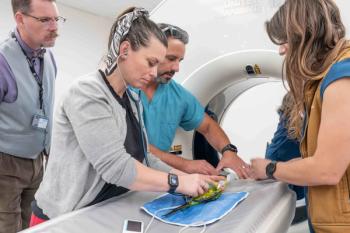
Radiographic evaluation of pulmonary patterns and disease (Proceedings)
Radiographic interpretation of pulmonary disease is a critical part of veterinary diagnostics, but can be one of the more intimidating areas of radiographic evaluation.
Radiographic interpretation of pulmonary disease is a critical part of veterinary diagnostics, but can be one of the more intimidating areas of radiographic evaluation. Utilizing a good understanding of normal radiographic anatomy as well as an organized, step-by-step approach, accurate interpretation of pulmonary disease is very likely.
Pulmonary disease usually results in either an increase or a decrease in radiographic opacity of the lungs. Most diseases result in an increase in opacity, usually characteristic for the pulmonary parenchymal component (alveolar, bronchial, interstitial, vascular) involved. These characteristic opacity changes are called lung patterns.
Identification of the lung pattern is helpful, as a list of differential diagnoses can be determined for that particular lung pattern. However, lung patterns can be non-specific, representing disease in transition (a disease process can progress or resolve through more than one lung pattern). The differential list, however, can be refined by using not only the identified lung pattern, but also:
1. Distribution of pulmonary opacity
a. Cranioventral distribution: aspiration or bronchopneumonia
b. Dorsal and hilar distribution: cardiogenic edema
c. Diffuse distribution: hematogenous spread
2. Presence of secondary abnormalities
a. heart enlargement
b. signs of trauma, such as rib fractures, pneumothorax
3. Signalment, history, clinical signs
4. In some cases, a lung aspirate or biopsy may be needed.
Lung Patterns
Alveolar Pattern
Alveolar pattern occurs when air in alveoli is replaced by fluid or cells, or not replaced at all (atelectasis).
Radiographic signs of an alveolar pattern include: (not all signs seen in every case)
1. Uniform, homogeneous fluid opacity, varying from faint or fluffy, to solid, complete opacification
2. Lobar sign: occurs when infiltrate (opacity) extends to periphery of lung lobe, and stops abruptly, leaving a dramatic transition between opacified lobe border and adjacent normal radiolucent lobe.
3. Silhouette effect: "border effacement", or loss of border visualization between heart and opacified lung lobe, or diaphragm and lung lobe. Occurs when the two fluid opacity structures are in close anatomic contact.
4. Air bronchogram: the classic sign of an alveolar lung pattern. Formed by air-filled bronchus extending through fluid opacity lung lobe. Bronchial walls are NOT seen; only bronchial lumen.
Left lateral thoracic radiograph of a dog with bronchopneumonia pneumonia. An alveolar pattern is noted ventrally (right cranial and right middle lung lobes). Air bronchograms are visible extending into the right middle lobe.
5. Distribution is usually focal or multifocal. Generalized, diffuse distribution is less common and occurs in very severe disease.
Ventrodorsal thoracic radiograph of a dog with bronchopneumonia involving the right middle lung lobe. A prominent lobar sign is present on both the cranial and caudal edge of the opaque right middle lung lobe. The right border of the heart is silhouetted by the alveolar opacity. An air bronchogram is visible within the opaque lobe.
Important points regarding the alveolar pattern:
1. The alveolar pattern is the dominant pattern, and will obscure other patterns by silhouette effect. This pattern results in more loss of airspace than any other pattern.
2. Diseases causing an alveolar pattern tend to come and go quickly; progress or resolve in a matter of hours in some cases; radiographs may change rapidly
3. Trans-tracheal washes or bronchoscopy and cytological evaluation often helpful in the diagnosis of diseases causing alveolar patterns
Common diseases associated with an alveolar pattern:
1. Pneumonia: appearance depends on route of infection
a. Bronchopneumonia and aspiration pneumonia: typically have a ventral distribution, most commonly affecting the right cranial, right middle, and left cranial lung lobes
i. Lesions begin at periphery and extend towards hilus as severity worsens
b. Hematogenous pneumonia: diffuse distribution; more common in foals
2. Pulmonary edema (severe)
a. Cardiogenic edema (left sided congestive heart failure): dorsal and hilar distribution
i. Typically also have enlarged left atrium and ventricle, venous congestion
ii. In severe, acute cases, more severe distribution in right caudal lung lobe may occur
iii. Cardiogenic edema in cats has a random distribution
iv. Response to diuretics may occur radiographically within 12-24 hours
b. Non-cardiogenic edema
i. Causes: electrocution, seizure activity or head trauma, near-drowning, acute severe hypoxia (such as acute airway obstruction), smoke inhalation; many other causes
ii. Typically caudal lung lobes most severely affected; starts at periphery, and extends towards hilus when severe
Left lateral radiograph of a dog with non-cardiogenic edema secondary to status epilepticus. Severe alveolar infiltrate is present in the caudal lung fields
3. Hemorrhage
a. secondary to trauma; may have any distribution, and can be very extensive
i. check for other signs of trauma such as rib fractures, pneumothorax
b. secondary to coagulopathy
VD image of a dog with chest trauma. Severe alveolar infiltrate with a prominent air bronchogram is present in the right middle and right caudal lung lobes secondary to hemorrhage.
4. Atelectasis
a. Alveolar opacity associated with loss of volume and mediastinal shift
b. Associated with bronchial obstruction or prolonged recumbency
Dorsoventral radiograph of a dog taken after prolonged left sided recumbency. Alveolar infiltrate is present in the left cranial lobe, with a mediastinal shift to the left.
5. Neoplasia
a. Rare cause of alveolar pattern; consider when the alveolar opacity has an atypical distribution (entire lobe affected without infiltrate anywhere else), or doesn't respond to therapy
b. Consider bronchoalveolar carcinoma, lymphosarcoma
6. Other uncommon causes of alveolar pattern
a. Lung lobe torsion; lobe consolidation often associated with pleural effusion
i. Usually right middle or left cranial lobe
ii. If air bronchograms visible, usually extend in abnormal direction
b. pulmonary thromboembolism
i. may see focal alveolar infiltrate, but often see no change, or focal hyperlucency
Interstitial Pattern
Interstitial pattern is divided into unstructured (linear interstitial) pattern, and structured, (nodular) interstitial pattern
Unstructured linear interstitial pattern occurs when there is thickening, fluid, or cellular infiltrate into the interstitial tissue. This is probably the most difficult pattern to accurately identify, and is often the "default" pattern, ie, it's not alveolar or bronchial, or vascular, so it must be interstitial. This pattern can be mimicked by exposure artifacts.
Radiographic signs of unstructured interstitial pattern:
1. overall increase in hazy, linear opacities
2. vasculature "smudged", but still visible (not silhouetted)
Left lateral thoracic radiograph of a geriatric dog. An unstructured interstitial pattern is present secondary to geriatric fibrosis
Etiologies of unstructured interstitial pattern
1. Artifact
a. Expiratory film
b. Underexposure
c. Obesity and scatter radiation causing "grayness" of the film
2. Geriatric fibrosis: benign "old age" changes
3. Interstitial pulmonary edema (early stages of edema; can progress to more severe alveolar pattern if not treated)
4. Hemorrhage (less severe form of hemorrhage; can progress to alveolar pattern if severe)
5. Interstitial pneumonia: viral, early or resolving bacterial pneumonia
6. Pulmonary fibrosis
7. Neoplasia
a. Lymphosarcoma, some rare primary lung neoplasias, metastatic pulmonary neoplasia
Lateral thoracic radiograph of a dog with mitral insufficienty and interstital pulmonary edema. An unstructured interstitial pattern is present in the dorsocaudal lung fields
Structured interstitial (nodular) pattern
Radiographic signs:
1. relatively circumscribed nodule/mass
a. nodule: < 3 cm
b. mass: > 3 cm
c. miliary nodules: multiple small nodules, 2-3 mm in size
i. may be hard to distinguish as tiny nodules; helps to look at thinner portion of lung or superimposed over more uniform soft tissue background such as ventral portion of heart, or liver
ii. diffuse distribution is typical
Etiologies for structured interstitial pattern:
1. Artifact of thoracic wall such as skin tumor, nipple, tick
2. primary pulmonary neoplasia
3. metastatic pulmonary neoplasia
4. fungal granulomas
5. abscess (more common in equine, ie rodococcus)
6. hematoma
7. fluid/blood filled bulla
8. cavitated mass/nodule (both air and soft tissue opacity)
a. neoplasia, abscess, traumatic bulla, parasitic cyst (Paragonimus)
Be careful not to mistake end-on vessels for pulmonary nodules. End-on vessels are smaller, often associated with the longitudinal vessel, and are increased in opacity compared to pulmonary nodules. Also be careful not to mistake body wall structures such as nipples, small skin nodules, or large ticks for true pulmonary nodules. Make sure you can identify pulmonary nodules on both lateral and VD/DV views before identifying them as pathologic. Skin lesions can be identified as such by coating them with a small amount of contrast agent (such as barium), and repeating the radiograph to see if the suspected nodule matches the contrast coated structure.
Left lateral radiograph of a dog with a large pulmonary mass (primary pulmonary carcinoma)
Bronchial Pattern
Bronchial pattern is caused by thickening and increased prominence of the bronchial walls, usually secondary to chronic inflammation. The walls are thickened due to a combination of smooth muscle hypertrophy, mucus production, cellular infiltrate, and in come cases (feline asthma), bronchoconstriction.
Right lateral radiograph of a dog with blastomycosis. A miliary nodular pattern is present.
Radiographic signs of bronchial pattern:
1. Thickened, end-on bronchi appear as rings, or "do-nuts"
2. Thickened bronchi seen longitudinally appear as parallel radiopaque lines, sometimes referred to as "railroad tracks"
Right lateral radiograph of a dog with chronic bronchitis. Thickened bronchial walls in the form of rings and parallel lines are distributed in all lung lobes
Etiologies of bronchial pattern
1. Chronic bronchitis secondary to allergic, infectious, inflammatory causes
a. May also see overexpanded lung fields due to air-trapping, either chronic or transient
b. Radiographic and clinical signs do not always correlate well
c. Acute bronchitis rarely shows radiographic signs (insufficient time for bronchial wall thickening to be visible radiographically)
2. Feline asthma
a. Thickened bronchial walls sometimes difficult to see due to small size
b. May have associated right middle lung lobe atelectasis
c. May have overexpanded lung fields due to acute bronchoconstriction and air trapping
3. Bronchiectasis
a. Irreversible dilation of bronchi due to very chronic airway inflammation
i. Dilated bronchi filled with fluid/mucus, and seen end-on, may appear as nodules
b. May be a congenital condition (ciliary dyskinesia); sometimes associated with situs inversus
c. May be transient (pseudobronchiectasis) if associated with pneumonia; resolves with treatment
4. Pulmonary infiltrates with eosinophilia (PIE)
a. Severe hypersensitivity reaction to an allergen; often heartworm disease
b. May have combined bronchial, interstitial (unstructured) and alveolar pattern if severe
c. Typically have marked peripheral eosinophilia
Vascular Pattern
Vascular pattern is present when pulmonary arteries and/or veins increase in prominence resulting in an increased pulmonary opacity.
Review of radiographic pulmonary vasculature
1. lateral view: vessels seen best in cranial lobes (left lateral view is best)
a. artery dorsal to vein, bronchus in between
b. artery and vein equal in size, smaller than proximal third of rib
2. VD/DV view: caudal lobar vessels seen best (DV view best)
a. Artery lateral to vein, bronchus in between
b. Vessels smaller than 9th rib where they intersect
Disease processes resulting in a vascular pattern:
1. heartworm disease
a. arteries larger than veins
b. main pulmonary artery enlargement
2. left sided congestive heart failure (venous congestion)
a. vein larger than artery
3. Left-to-right shunt (PDA, VSD)
a. Enlargement of both arteries and veins
4. Decreased prominence of vasculature resulting in hyperlucent lung field
a. Right to left shunt
b. Hypovolemic shock
c. Severe dehydration
d. Thromboembolic disease
Lateral radiograph of a dog with patent ductus arteriosus. The pulmonary arteries and veins in the cranial lobes are enlarged and prominent, consistent with pulmonary overperfusion and left to right shunt.
Mixed Pattern
Most pulmonary diseases result in a mixed pattern, although one pattern may predominate.
Dosoventral radiograph of a dog with heartworm disease. The caudal pulmonary arteries are markedly enlarged, as is the main pulmonary artery.
Newsletter
From exam room tips to practice management insights, get trusted veterinary news delivered straight to your inbox—subscribe to dvm360.






